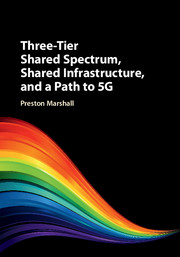Book contents
- Frontmatter
- Contents
- Acknowledgments
- Preface
- Part I Spectrum Sharing Background
- Part II Three-Tier Dynamic Spectrum Models
- Part III Components of a Three-Tier Architecture
- Part IV Protection Processes for Incumbents and Peers
- Part V Example Use of Three-Tier Spectrum: Use of the 3.5 GHz CBRS Band in the USA
- Part VI Future Bands, Network Services, Business Models, and Technology
- 15 Potential Services and Business Models Enabled by Three-Tier Spectrum
- 16 Candidate Incumbent Bands for Three-Tier Spectrum Sharing
- 17 From Shared Spectrum, to Shared Infrastructure, to a New Model of 5G
- 18 Future Actions to Deploy More Three-Tier Spectrum Bands and Nations
- 19 Alternatives to Three-Tier Operation
- 20 Conclusions and a Look Ahead
- Part VII Appendices
- Index
- References
19 - Alternatives to Three-Tier Operation
from Part VI - Future Bands, Network Services, Business Models, and Technology
Published online by Cambridge University Press: 30 August 2017
- Frontmatter
- Contents
- Acknowledgments
- Preface
- Part I Spectrum Sharing Background
- Part II Three-Tier Dynamic Spectrum Models
- Part III Components of a Three-Tier Architecture
- Part IV Protection Processes for Incumbents and Peers
- Part V Example Use of Three-Tier Spectrum: Use of the 3.5 GHz CBRS Band in the USA
- Part VI Future Bands, Network Services, Business Models, and Technology
- 15 Potential Services and Business Models Enabled by Three-Tier Spectrum
- 16 Candidate Incumbent Bands for Three-Tier Spectrum Sharing
- 17 From Shared Spectrum, to Shared Infrastructure, to a New Model of 5G
- 18 Future Actions to Deploy More Three-Tier Spectrum Bands and Nations
- 19 Alternatives to Three-Tier Operation
- 20 Conclusions and a Look Ahead
- Part VII Appendices
- Index
- References
Summary
Introduction
This chapter considers some of the alternative future concepts and approaches that can serve as alternatives to the three-tier approach. They are considered in the context of the evaluation criteria used in Chapters 3 and 4. Where there are shortfalls in our three-tier criteria, methods of resolving them without the implementation of a three-tier regime will be explored.
Cognitive Radio
Cognitive Radio (CR) has been a concept that has had considerable research performed in the academic community, and has achieved some interest in the commercial world, as well. There are significant overlaps between the three-tier concept and CR. The fundamental difference in the academic CR research is that the CR device makes spectrum decisions based on its perception of conditions, and in three-tier, it is centralized in a database-driven process, with very little spectrum decision-making performed by the radio.
It should be noted that many of the participants in the President's Council of Advisors on Science and Technology (PCAST) study were active researchers in the field of CR. It is instructive to consider why the PCAST recommendations did not include more of the CR fundamental concepts. Some of the reticence to advocate for CR principles is undoubtedly to create a lower risk set of proposals, and thus increase the likelihood that the recommendations could not be effectively challenged. But there were also challenges that current CR technology could not address, as well.
Sensing As discussed in the section on Television White Space (TVWS), there are difficulties in relying on sensing as a mechanism to create awareness of other devices operating in the band, unless the uses are consistent with sensing, which many existing uses are not.
Tier Detection Even if the sensing problem is solved, the ability to determine the status of the tier they are operating in is difficult, if not impossible, if multiple tiers have common technologies. In the band considered by the United States (US) PCAST study, the primary incumbent is a radar with a single set of operating characteristics and is always the primary, so there is no difficulty in detecting the radar, and determining its tier. However, the second and third tiers have no technology limitations, and cannot be differentiated through sensing methods.
- Type
- Chapter
- Information
- Publisher: Cambridge University PressPrint publication year: 2017



